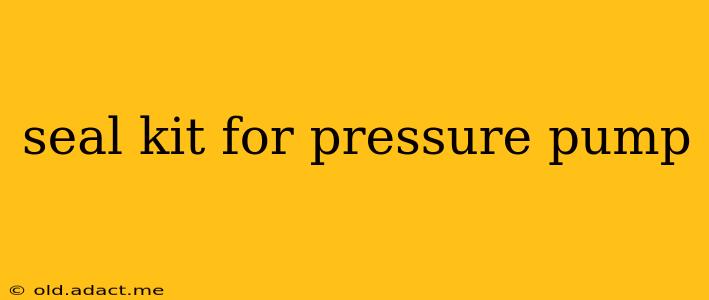Finding the right seal kit for your pressure pump can feel overwhelming. With so many variations and components, knowing where to start is crucial for ensuring your pump operates efficiently and reliably. This comprehensive guide will walk you through everything you need to know about pressure pump seal kits, from understanding the different types to identifying the perfect fit for your specific needs.
What is a Pressure Pump Seal Kit?
A pressure pump seal kit is a collection of replacement seals and gaskets designed to restore the proper sealing within your pressure pump. These seals prevent leaks and maintain the necessary pressure for optimal functionality. Over time, these seals can wear down, degrade due to exposure to chemicals, or become damaged, resulting in leaks and decreased performance. Replacing them with a fresh seal kit is a cost-effective way to extend the life of your pump and prevent more significant, costly repairs. The kit typically includes various seals, O-rings, and gaskets crucial for sealing different parts of the pump's hydraulic system.
What are the Different Types of Pressure Pump Seal Kits?
The type of seal kit you'll need depends entirely on the make, model, and specific type of your pressure pump. There's no one-size-fits-all solution. Some common types of seals found in pressure pump kits include:
- O-rings: These circular seals provide a basic seal between components. They are common and relatively inexpensive.
- Lip seals (or shaft seals): These seals are designed to prevent leakage between a rotating shaft and a stationary housing. They are crucial for preventing fluid from escaping around the pump's shaft.
- Face seals: These seals use a flat, precision-ground surface to create a leak-proof seal, often found in high-pressure applications.
- Gaskets: These flat seals are used to create a seal between two mating surfaces, such as pump housings or flanges.
How to Identify the Correct Seal Kit for My Pressure Pump?
Identifying the correct seal kit is paramount. Improperly sized or unsuitable seals will lead to further problems. Here's how to find the right one:
- Locate your pump's model number and manufacturer: This information is usually found on a label affixed to the pump itself.
- Consult your pump's manual or the manufacturer's website: The manual should list the correct seal kit part number or provide guidance on finding the right one.
- Contact the pump's manufacturer or a reputable supplier: If you can't find the information yourself, contacting the manufacturer or a specialized supplier is the best way to ensure you get the correct components.
- Examine the old seals: If you have access to the old seals, you can use them as a reference when ordering a replacement kit. Take careful measurements and note the material type if possible.
How Often Should I Replace My Pressure Pump Seal Kit?
The frequency of seal kit replacement depends on several factors:
- Pump usage: Frequent or heavy use will accelerate wear and tear.
- Fluid type: Certain fluids are more aggressive and can degrade seals faster than others.
- Operating conditions: High temperatures and pressures can shorten the lifespan of seals.
Regular inspections for leaks and wear are essential. It’s better to replace the seal kit proactively before a major leak occurs rather than reacting to a failure.
What Happens if I Don't Replace a Worn-Out Seal Kit?
Ignoring a worn-out seal kit can lead to several issues:
- Leaks: The most immediate consequence, leading to fluid loss and potential environmental hazards.
- Reduced pressure: Leaks reduce the pump's ability to build and maintain pressure, compromising its efficiency.
- Pump damage: Continued operation with damaged seals can cause further damage to internal pump components, leading to costly repairs.
- Downtime: A complete pump failure due to seal issues will result in costly downtime and disruptions.
Can I Repair Individual Seals Instead of Replacing the Entire Kit?
While it's possible to replace individual seals, it's generally recommended to replace the entire kit. This ensures all seals are compatible and in good condition, minimizing the risk of future leaks or failures. Furthermore, the cost difference between individual seals and a complete kit is often minimal.
This comprehensive guide provides a solid foundation for understanding pressure pump seal kits. Remember always to prioritize safety and consult the manufacturer's instructions when handling and maintaining your pressure pump. Using the right seal kit is crucial for ensuring the longevity and efficiency of your equipment.
